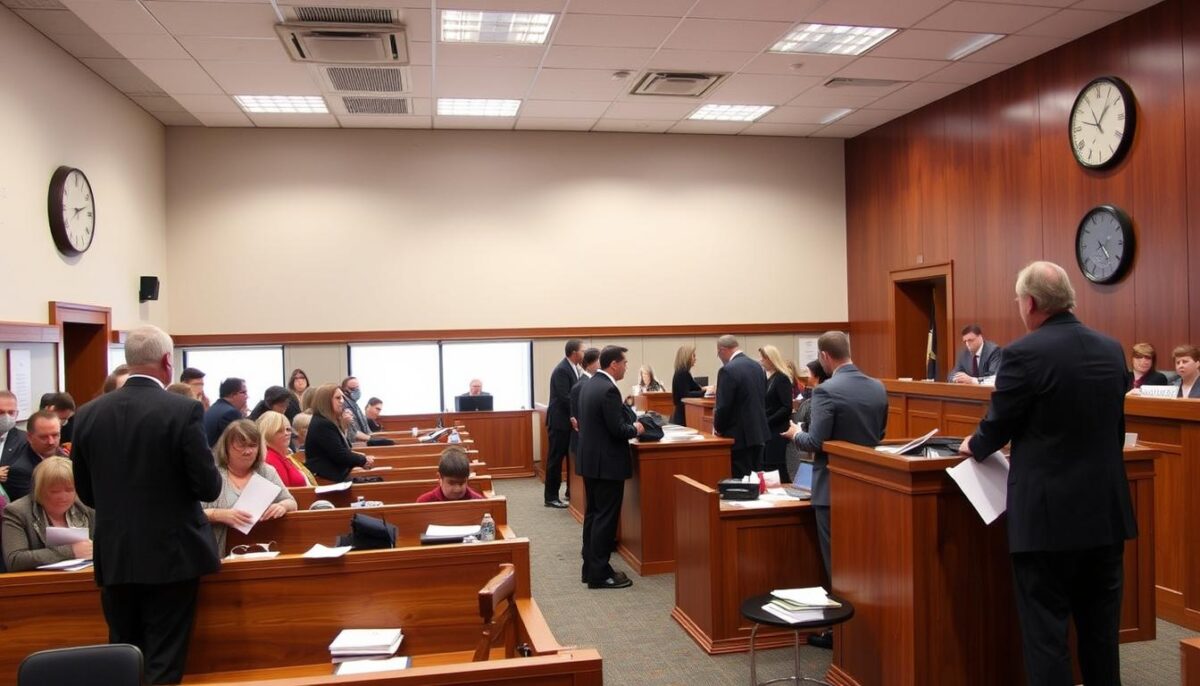Divorce can be tough, especially in Travis County. It’s important to know the legal steps to move forward. Learning how to finalize a divorce in Travis County helps you make smart choices and feel in control.
In Texas, one spouse must meet residency rules. This rule applies even if one spouse lives abroad. The Texas Family Code also recognizes foreign marriages, affecting international divorces in Texas. Knowing these rules is key, as serving divorce papers abroad can be complex.
This article will guide you through the divorce process in Texas. We’ll cover the needed documents, divorce grounds, and why legal help is crucial. With the right preparation, you can handle the Travis County divorce court and protect your rights.
Understanding the Divorce Process in Travis County
Going through a divorce in Travis County can be tough, especially if you’re new to the legal world. There are different kinds of divorces, important papers to fill out, and timelines to keep in mind. It’s a challenging time, but knowing what to expect can help.
Overview of Divorce Types
In Travis County, divorces are mainly uncontested or contested. An uncontested divorce happens when both sides agree on everything, like who gets what and custody of kids. This usually means a quicker end to the divorce, which is less stressful for everyone involved.
A contested divorce, on the other hand, means the couple can’t agree. This often leads to longer court fights and higher legal costs.
Required Documents
To start a divorce in Travis County, you need to file certain divorce paperwork Texas. You’ll need to submit the Original Petition for Divorce, which explains why you’re getting a divorce and what you want. You also have to provide:
- Financial Information Statements
- Child Support Worksheets (if applicable)
- Affidavit of Financial Disclosure
- Proposed Parenting Plan (if children are involved)
Timeline for Divorce Proceedings
The time it takes to finish a divorce in Travis County can vary a lot. An uncontested divorce might take 60 to 90 days. But a contested divorce could take months or even over a year, especially if you go to court.
About 70% of divorces in Travis County are settled without going to court. This shows how important it is to try to agree and use mediation.
For more help with the divorce process, you can check out divorce resources online. Knowing what to expect can make this difficult time easier to get through.
Grounds for Divorce in Texas
Knowing the grounds for divorce is key when going through an uncontested divorce in Texas. The state has two main types: no-fault and fault-based. Each has its own rules and effects. Understanding these can help shape my divorce journey.
No-Fault Divorce
No-fault divorce means I don’t have to blame anyone. Saying irreconcilable differences is the main reason. This makes the divorce process faster and less stressful. It helps couples agree on things like money and kids without fighting over fault.
Fault-Based Divorce
Fault-based divorce, on the other hand, requires proving fault. This can be due to adultery, cruelty, or abandonment. Knowing these grounds is important, especially if one side wants a better deal financially.
| Type of Divorce | Advantages | Disadvantages |
|---|---|---|
| No-Fault Divorce | Simpler process, less conflict, quicker resolution | Lack of fault may complicate financial settlements |
| Fault-Based Divorce | Potentially higher settlements, establishes accountability | More time-consuming, emotionally taxing |
The choice between no-fault and fault-based divorce depends on my situation and goals. Knowing my options helps me make choices that are best for me.
Filing for Divorce in Travis County
Starting a divorce in Travis County means following several important steps. I must file the Original Petition for Divorce with the Travis County District Clerk. This petition is the formal request to end the marriage. It’s crucial to fill it out correctly, as it outlines the reasons for divorce and any requests for property or child custody.
How to File the Petition
To begin, I need to gather certain information and documents. These include:
- Full names and addresses of both spouses
- Date of marriage and separation
- Information about children, if applicable
- Details of any property or debts acquired during the marriage
After gathering this information, I can get the petition form online or from the Travis County District Clerk’s office. I’ll need to file it in person or use online filing options, which have grown by 20% in two years. Getting help from a Travis County divorce attorney is a good idea to make sure everything is done right.
Filing Fees and Payment Options
The cost to file for divorce in Travis County can range from $300 to $500. If there are child custody disputes or other complexities, the cost can go up to $15,000. To manage these costs, I can look into different payment options. The District Clerk’s office accepts cash, check, or credit card. Online filing might also offer similar payment options.
Knowing about the filing process can help me get through this tough time better. For more information, I can check out guides from experienced professionals.
Serving Your Spouse
Starting the divorce process in Travis County means serving your spouse with legal papers. It’s key to do this right. It shows the court has power over your spouse and lets the case move forward. I’ll explain how to serve divorce papers and what happens while waiting for a response.
Methods of Service
There are several ways to serve divorce papers in Travis County. Each has its own rules and benefits:
- Personal Service: This is the most direct way. It involves giving the papers to your spouse in person. A process server or someone not involved in the case can do this.
- Service by Certified Mail: This method sends the documents via the United States Postal Service. It’s tracked, and your spouse must sign for it.
- Substituted Service: If finding your spouse is hard, you can serve someone else at their last known address or workplace. You need to follow certain steps.
- Service by Publication: This is for when you can’t find your spouse. Legal notices will be published in a local newspaper. But, it can make the divorce take longer.
Waiting for Response
After serving your spouse, they have 20 days to reply to the divorce petition. This waiting time can affect when the divorce is final in Travis County. If they don’t respond, you might get a default judgment. Knowing what happens in each case is important:
- If Your Spouse Responds: They might fight the divorce or agree to terms. This could lead to negotiations.
- If No Response is Received: You can get a default judgment. But, you must tell the court and show you tried hard to serve your spouse.
Understanding these steps helps as I go through the divorce process in Travis County. The outcome will impact the final divorce decree and future arrangements.
Temporary Orders During Divorce
Going through a divorce can be tough. Temporary orders help keep things stable until the divorce is final in Texas. They cover important things like where kids live, who pays support, and who handles money matters. Knowing about these orders and how to ask for them is key for those facing divorce in Travis County.
Types of Temporary Orders
There are several key areas that temporary orders cover during a divorce. Here are some common ones:
- Temporary Child Custody Orders: Decide where kids will stay while the divorce is being worked out.
- Temporary Spousal Support Orders: Give financial help to one spouse after they split up.
- Temporary Restraining Orders: Stop one spouse from making big money moves or selling things.
How to Request Temporary Orders
Getting temporary orders in Travis County means following a certain legal step. First, I need to file a motion for the orders I want. This might mean providing some documents and possibly going to a hearing. Courts aim to keep everyone stable, so it’s important to make a strong case.
Getting help from lawyers can really help understand this process better. For more information, check out this resource.
Preparing for Court Hearings
Going to the Travis County divorce court can feel overwhelming. Knowing what to expect makes it easier. Court sessions include judges, lawyers, and sometimes witnesses. Being well-prepared helps a lot.
What to Expect in Court
Several important things happen in court:
- Judges look at the evidence from both sides.
- Each person gets to share their story.
- The emotional and financial effects of divorce are talked about.
- Decisions on child custody, support, and assets are made.
Tips for Effective Representation
Whether I represent myself or have an attorney, being well-represented is key. Here are some tips:
- Learn about Texas laws to know my rights.
- Wear professional clothes to make a good impression.
- Practice explaining my side clearly and briefly.
- Stay calm and respectful during the hearings.
Gathering Evidence
Gathering evidence is crucial for the divorce settlement. Important evidence includes:
| Type of Evidence | Purpose |
|---|---|
| Financial Records | To show income and expenses for fair division. |
| Witness Testimonies | To support claims on child custody and more. |
| Relevant Documentation | To show the marriage’s history, like communication records. |

Finalizing Your Divorce Settlement
Finalizing a divorce in Texas means working out many details. This includes how to split assets and who gets custody of the kids. It’s important to talk openly and be willing to compromise. This can help both sides agree on a good divorce settlement agreement.
Negotiating Terms
Getting the terms of a divorce right is key. Knowing Texas laws about dividing assets is crucial. Most things bought during the marriage are split equally. This includes homes, bank accounts, and retirement plans.
Child custody is also a big topic. It’s all about what’s best for the kids.
Mediation Process
Mediation is a great way to avoid court battles. It’s a process where a neutral person helps you talk things out. This can lead to a divorce settlement agreement that really fits both sides.
Mediation is faster and cheaper. It also helps keep things calm, which is good for everyone involved.
| Aspect | Litigation | Mediation |
|---|---|---|
| Cost | Generally higher due to court fees and legal representation | Typically lower due to fewer attorney hours and quicker resolution |
| Time | Can take months or years to reach a final decision | Often resolves within weeks or a few months |
| Control | Court decides terms, parties have limited input | Parties have significant control over the outcome |
| Emotional Impact | Often adversarial, leading to heightened conflict | Collaborative, frequently resulting in less emotional distress |
Completing Your Divorce Decree
Knowing the last steps of the divorce process in Travis County is key. It makes sure all legal duties are done and both sides know the divorce decree terms. The final divorce decree in Travis County is a legal document. It outlines the agreed-upon terms of the marriage’s end.
What is a Divorce Decree?
A divorce decree is the court’s official document ending a marriage. It lists the divorce terms agreed upon by both spouses or decided by the court. This decree is more than just ending a marriage. It’s a legal document that can be enforced if someone doesn’t follow it.
Information Included in the Decree
The final divorce decree in Travis County covers important details. These details help enforce the divorce order. They often include:
- Custody Arrangements: Details on who gets custody of the children and visitation rights.
- Property Distribution: How to divide marital assets and debts.
- Support Obligations: Details on child support and alimony.
- Legal Ratification: Proof that both parties agree to the terms and can enforce them legally.
These parts are crucial for avoiding future disputes. They help people understand their rights and duties after divorce.
| Element | Description |
|---|---|
| Custody Arrangements | Defines terms for child custody and visitation rights. |
| Property Distribution | Outlines how assets and debts are to be divided. |
| Support Obligations | Details regarding child support and alimony payments. |
| Legal Ratification | Shows mutual agreement of the terms by both parties. |
Getting your divorce decree done marks the end of your marriage. It also sets the stage for future interactions, like co-parenting or financial matters. Knowing what the decree says is key for following it and making the transition to post-divorce life smoother.
Appearing in Court
Attending your hearing in the Travis County divorce court is a big deal. Knowing how to act and prepare is key. It makes the whole process smoother and more respectful.
The Courtroom Procedure
Walking into the courtroom can be scary. First, I get to know the room. I pick a spot where I can wait quietly without disturbing others. When the judge comes in, I stay silent and respectful.
- Stand when the judge enters and exits the courtroom.
- Address the judge as “Your Honor” at all times.
- Wait for permission before speaking or approaching the bench.
- Stay composed and avoid showing emotional reactions to what’s happening during the proceedings.
Speaking to the Judge
When it’s my turn to speak, I speak clearly and with respect. I make sure to get my points across quickly. Knowing the legal process helps me talk to the judge effectively.
| Preparation Tips | Impact on Court Hearings |
|---|---|
| Practice what you want to say | Boosts confidence and clarity |
| Dress professionally | Demonstrates respect for the court |
| Bring necessary documents | Supports my case effectively |
| Remain calm and respectful | Encourages positive interactions |

By following these steps, I can get a better outcome in court. Knowing the procedures helps me present my case well. It’s important to learn about divorce to understand the process better.
For more information on divorce, check out this useful resource.
Post-Divorce Considerations
After a divorce, you might need to update some personal info. This ensures everything stays current and correct. Knowing what to do next helps make the transition smoother.
Changing Your Name
If you want to change your name after the divorce, you’ll need to follow a few steps. You can go back to your maiden name or pick a new one. Make sure the name change is in the final divorce decree.
This makes it easier to update your records. You’ll need to do this with places like the Social Security Administration and the Department of Motor Vehicles.
Updating Legal Documents
After the divorce, you’ll need to update some legal papers. This includes:
- Wills and estate plans to make sure your assets go where you want.
- Insurance policies, like health and life insurance, to remove your ex-spouse as a beneficiary.
- Financial accounts and investment records to keep your legal obligations up to date.
These steps help avoid legal problems and keep your personal info consistent. It’s important to act quickly after the divorce to avoid future issues.
Filing the Final Divorce Decree
Getting a divorce in Travis County means filing the final decree. This document ends the divorce case. It’s important to know where and how to file it, and to follow its rules for a smooth transition.
Where and How to Submit
To file the final divorce decree in Travis County, I need to:
- Get all needed divorce paperwork Texas, like the final decree and documents for child custody or property.
- Go to the district court clerk’s office in Travis County.
- Submit the final divorce decree and any extra documents for review.
- Pay any court fees. You can use a check, cash, or credit card, depending on the court.
Ensuring Compliance
After filing the final divorce decree, I must follow its rules. This document covers important agreements on child support, custody, and assets. Not following these rules can lead to legal problems. For example:
- Not paying child support can cause legal actions.
- Breaking custody agreements can change visitation rights.
So, I should read the decree carefully and follow it to make the post-divorce life better.
| Document | Action Required | Notes |
|---|---|---|
| Final Divorce Decree | File with court | Make sure all parties receive a copy |
| Child Support Agreement | Include with decree | Necessary for financial obligations |
| Property Settlement | Attach to filing | Outlines division of assets |
Resources for Divorce in Travis County
Going through a divorce in Travis County can feel like a big challenge. But, there are many resources to help you. You can find legal help or emotional support, which is very important. Local legal aid services can guide you on filing documents and understanding your rights. They are especially helpful if you’re thinking about getting a Travis County divorce attorney.
Local Legal Aid Services
In Travis County, places like Legal Aid of Northwest Texas offer free or low-cost legal help. They assist with paperwork, court procedures, and give advice for your case. If money is tight, getting help from local legal aid can be a big help in managing your divorce.
Online Resources and Support Groups
Online platforms are also key in getting help. Sites like Avvo and LegalZoom have lots of info on divorce, including articles and forums. You can also find support groups on Facebook or at local community centers. These groups offer comfort and shared experiences with others going through the same thing. Connecting with others, online or in person, can make the emotional part of divorce easier.

